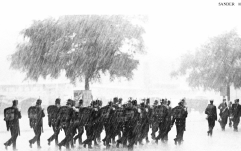Slaves, and
Gold
David E. Fisher

But these gold mines did not exist. The gold in those islands was present in tracer deposits only. Enough washed down through the streams for the Indians to use for jewelry, but what was enough gold for a few thousand Indian trinkets was not enough to turn the Spanish galleons into heavily laden armories of wealth.
Columbus tried to counter the complaints brought back by his men to the Spanish king and queen with gifts of as much gold as he could squeeze out of the islands, but this was not enough to satisfy Their Majesties. So he also brought back thirty natives to convince his sponsors of another source of riches: slavery.
These natives, he told King Ferdinand and Queen Isabella, were ignorant of the one true Lord. It was one of the things he loved about them, for being without religion they were as innocent as babes and could easily be converted to the true faith. (He never considered the native religion, which encompassed a wide spectrum of gods and goddesses, as worthy of consideration.)
The other thing he loved about them was that they were friendly and guileless, unassuming and unwarlike; in short, perfect for slavery. He evidently saw no conflict between the desire to save them for Christianity and his wish to use them as slaves. Their Majesties could, he said, at the same time save their souls for God and use their bodies for Spain.
One should note that he was not behaving in an inhuman manner in thinking of the Indians as a source of slaves. On the contrary, he was all too human. Slavery was not invented by the white Europeans, nor is it a vice peculiar to them. Everyone practiced it, wherever and whenever they could: the ancient Greeks and Romans, as well as all other ancient peoples. (The Hebrews included a provision that a man held as slave must be set free after seven years; in all other cultures, slavery was for life.)
In more modern times slavery was still ubiquitous. African blacks took their captives as slaves, and even initiated wars specifically to gather slaves, either for their own use or to sell to the white men. Arabs traded in slaves, and many of the Indian tribes of the New World kept Spanish castaways, victims of hurricanes, as slaves. In the days before we had machinery to work for us, the temptation to take a weaker ("inferior") person as a slave must have been irresistible.
The Spanish sovereigns in particular would not be the ones to cavil at Columbus's suggestion. They had just finished rounding up the Jews, dispossessing them of everything they owned, and expelling them from their kingdom. This, after years of trying to save their souls for God by burning their bodies at the stake, is evidence enough that rulers such as these were not likely to make too fine a moral point out of enslaving dark-skinned people.
Nor indeed did they, accustomed as they were to the joys of the Inquisition, when not only Jews but Protestants, Moors, and Gypsies, intellectuals and atheists, were all burned at the stake to be rid of heresy. A story was told in Spain during the 1490s about a certain nobleman who died and went to heaven. The Lord accompanied him down the long halls of the heavenly castle, pointing out to him the various rooms from among which he could choose his eternal paradise. "In here," the Lord said, "are the Chinamen and Indians who call themselves Buddhists. Along here," He said, continuing on down the hall, "are the Lutherans, down here are the Protestants, here the Moors, and there the Russian Orthodox." And then as they came upon the next room the Lord rose up on His tiptoes and put His finger on His lips. "Shh," He whispered, and they passed by that door quietly and went on. "Here we have the Jews," the Lord said as they came upon the next room, at which point the nobleman begged to interrupt Him and asked, "What about that room back there? The one we tiptoed past?" "Shh," the Lord whispered again. "That room is for the Catholics. They think they're the only ones up here."
Well, I suppose they didn't really tell that story in Spain in the 1490s, as Christian arrogance was no laughing matter. Certainly not for the Jews who were burned, nor for the West Indians who would be enslaved. Of course according to the prevailing point of view, it was all done in their best interests. As Washington Irving says, "Nor were the interests of the unhappy natives forgotten by the compassionate heart of Isabella...[who] always consented with the greatest reluctance to the slavery even of those who were taken in open warfare; while her utmost solicitude was exerted to protect the unoffending part of this helpless and devoted race. She ordered that the greatest care should be taken of their religious instruction..."
Isabella's "compassion" didn't seem to help; the Indians were more than enslaved, they were annihilated. For Columbus was wrong to assume their docility and eagerness to please would make them suitable candidates for servitude. When they were enslaved they either fought back or withered away; either way, they died.
 Of the 300,000 Tainos indians inhabiting Hispaniola when Columbus first made landfall there in 1492, one third were killed by 1496. In 1508 a census showed only sixty thousand still alive, in 1512 the
number was twenty thousand, and by the middle of that century the Spanish governor of the island reported that fewer than five hundred Indians were to be found. Today none remain.
Of the 300,000 Tainos indians inhabiting Hispaniola when Columbus first made landfall there in 1492, one third were killed by 1496. In 1508 a census showed only sixty thousand still alive, in 1512 the
number was twenty thousand, and by the middle of that century the Spanish governor of the island reported that fewer than five hundred Indians were to be found. Today none remain.
But at the time Columbus's arguments pleased the Spanish sovereigns, and they sent him back twice more to the Indies to find a path to China, to find the Indians' hidden gold mines, and to bring back armies of slaves. In order to keep the peace among the colonizers, however, Ferdinand ordered him not to interfere with the new administration of the islands, which was to be set up without him. On his fourth and final voyage, in 1502, Columbus's main mission was to get to China, but he was forced to take a detour. His flagship on that trip, La Capitana, proved untrustworthy on the transatlantic voyage, and so he put into the port of Santo Domingo to attempt to replace her. He also wanted to find shelter there from a hurricane that he felt coming.
I use the phrase "felt coming" because I can't think of a better one. The signs he listed as indicative of the impending storm are less than sure: cirrus clouds scudding along ahead of an "oily" rolling swell of ocean waters otherwise suspiciously smooth, like glass; light winds with sudden sharp gusts; large sea creatures (seals, manatees, and unidentified shapes) coming to the surface, apparently deserting the turmoil of the deep waters; and perhaps most telling, sharp pains in his rheumatic or arthritic bones. Somewhat less than a scientific basis, especially for a sailor who had seen only one hurricane (possibly two) before, but as it turned out he was right.
Knowing he was forbidden to land in Santo Domingo, he hove to offshore and sent one of his officers to ask for sanctuary. The governor, Nicolás de Ovando, refused his request and told him to shove off, in more or less those words.
When he received the curt reply, Columbus sent his officer back with a letter assuring Ovando that a hurricane was truly coming, and implored him at least to make sure his own ships were safe. Ovando laughed at the warning, while reading the letter aloud to his grinning court. His fleet was ready to sail to Spain with a fortune in gold --- including one ship with the largest single mass ever seen on these islands, and another laden with Columbus's personal fortune of four thousand pieces --- and he was not going to let Columbus interfere. Especially not with such nonsense. Looking out on the harbor, they could all see a day fair and tranquil, with not a hint of a storm in the sky.
Ovando's fleet sailed on the morrow, as Columbus took his own group of ships along the coast and found an inlet to shield them from the easterly winds he was expecting. Two days later, the storm struck:
The baleful appearance of the heavens, the wild look of the ocean, the rising murmur of the winds, all gave notice of its approach. The fleet [Ovando's] had scarcely reached the eastern point of Hispaniola when the tempest burst over it with awful fury, involving everything in wreck and ruin. The ship aboard which...were a number of the most inveterate enemies of Columbus was swallowed up with all its crew, and with the celebrated mass of gold, and the principal part of the ill-gotten treasure gained by the miseries of the Indians. Many of the ships were entirely lost...and only one was enabled to continue her voyage to Spain. That one was the weakest of the fleet and had on board the four thousand pieces of gold, the property of the Admiral.
Nineteen ships disappeared with all hands; another half-dozen were lost, but from these somehow a few sailors survived; and four managed to get back into harbor before they sank. Altogether, more than a million dollars in gold sank under the waves. And the Aguja, with Columbus's gold, sailed on to Spain.
The man was a demon, everyone agreed, who had obviously made a pact with the devil. Columbus himself saw it a bit differently:
"He was deeply impressed with awe, and considered his own preservation as little less than miraculous. Both his son Ferdinand and the venerable historian Las Casas, looked upon the event as one of those awful judgments which seem at times to deal forth temporal retribution."
©1994, Random House